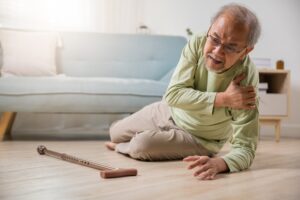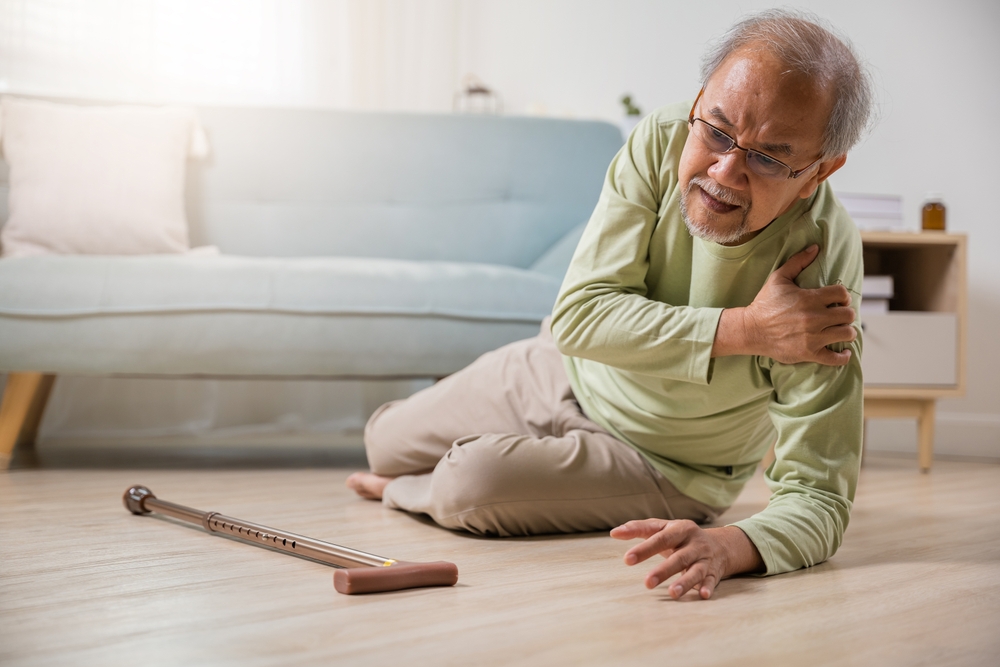Falls are a significant concern for the elderly, often leading to serious injuries. Implementing safety measures at home can significantly help prevent falls and ensure a safer living environment for seniors.
What Causes the Elderly to Fall
If your parent or loved one has recently experienced a fall, it could be a sign that they need more help. There are a number of scenarios that can make seniors more susceptible to falls:
- Age-related changes
- Weakening muscles and joints
- Medication side effects
- Balance issues
- Lack of activity
- Poor diet
- Lack of water
- Lack of sleep
- Trip hazards
- Incorrect shoes
- Health complications
Home Safety Tips for Fall Prevention
 For seniors living at home, or individuals transitioning from a nursing home to their own home, it’s crucial to ensure the home environment is safe and free from hazards that could increase the risk of falls.
For seniors living at home, or individuals transitioning from a nursing home to their own home, it’s crucial to ensure the home environment is safe and free from hazards that could increase the risk of falls.
Stairways & Hallways
Ensure these areas are well-lit and free from clutter. Install sturdy handrails on both sides of staircases and use non-slip treads on steps.
Bathrooms
Install grab bars in the shower and near the toilet. Use non-slip mats and consider a shower chair for added stability.
Bedrooms
Keep pathways clear and ensure that lighting is easily accessible from the bed. Consider a nightlight for nighttime visibility.
Kitchen
Store frequently used items within easy reach to avoid using step stools. Keep floors dry and uncluttered.
Outdoor Spaces
Repair uneven surfaces on pathways and driveways. Use outdoor lighting to improve visibility and remove debris that could cause tripping.
Other Living Areas
Arrange furniture to create clear walkways. Remove loose rugs or secure them with non-slip backing.
Fall Prevention Exercises
Regular exercise strengthens muscles and improves balance, reducing the risk of falls. Activities like yoga, water aerobics, and balance training are great ways to increase mobility and avoid tripping. Consider joining exercise classes for seniors for structured support and social engagement.
General Fall Prevention Tips
There are many ways you can easily and immediately implement fall prevention practices at home:
Wearing the Right Shoes
Opt for shoes with non-slip soles and good support. Avoid high heels and slippers without grip.
Remove Fall Hazards
Clear random items and unnecessary furniture from high-traffic areas to prevent tripping.
Ensure All Areas Are Well Lit
Use bright, easily accessible lighting throughout the home to improve visibility.
Assistive Devices
Install handrails in critical areas and use non-slip mats in the bathroom and kitchen.
Avoid Loose Clothing
Wear well-fitting clothes to prevent tripping over fabric.
Living on One Level
Consider a single-level living arrangement to avoid stairs and reduce fall risk.
Exercise
Incorporate regular physical activity to maintain strength and balance.
The 5 Ps of Fall Prevention
As a child of an aging parent, a caregiver, or even as a senior yourself, it’s important to understand the following 5 essential ways to prevent falls.
Pain
If you are experiencing pain, address the issue promptly as it can affect your balance and mobility.
Potty
Ensure safe and quick access to bathroom facilities to prevent rushed movements. Get any necessary assistance you need to reduce any possible risks of injury.
Periphery
Maintain clear peripheral vision by addressing any visual impairments. Get your eyes checked regularly to be sure you have everything you need to assist your vision.
Position
Be mindful of body positioning and movement to avoid awkward or risky actions. Ask your family member or caregiver to help you get into a comfortable position.
Personal Items
Check that all your essential items are within reach — your glasses, phone, emergency calling device, a cup of water, etc. If you have company, check to see if they can bring you anything you need before they leave.
Why You Should Make an Appointment with Your Healthcare Provider
It’s a good idea to speak with your healthcare provider about fall prevention strategies and their recommendations based on your medical history. Specifically, a healthcare provider would be able to review any medications you’re taking for side effects that affect balance. Checking in regularly with your healthcare provider can help identify and address risk factors based on past falls or health changes.
A healthcare provider can also recommend a CDPAP agency for individuals who require at-home services, or the NHTD Waiver Program, for nursing-home-eligible individuals who wish to remain at home.
Americare Can Help
Maintaining a safe home environment is crucial for the well-being of seniors living at home.
Every day, Americare provides home health services to seniors in New York. These services include home health aides, skilled nurses, and CDPAP options, for seniors who require daily assistance but wish to remain at home. Our professionals are trained to implement fall prevention measures tailored to individual needs.
Reach out to us at Americare to learn more about your home health care options, and for help with fall prevention strategies.

